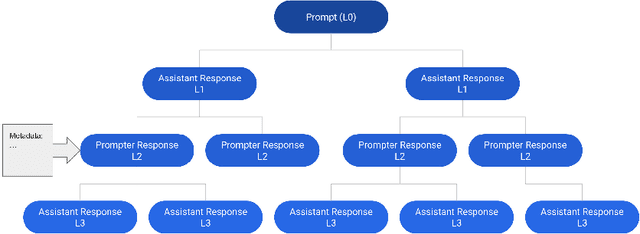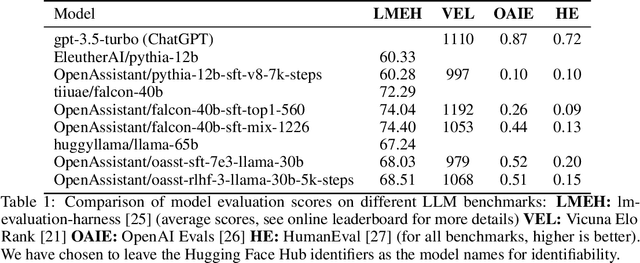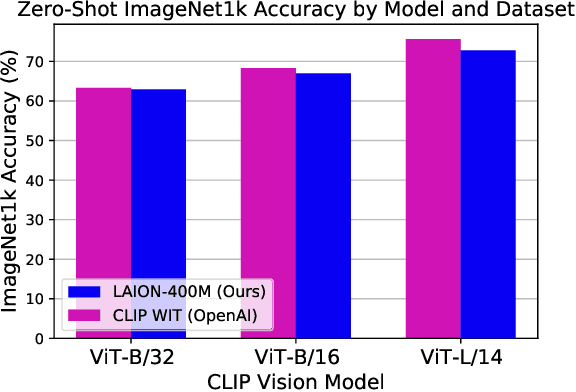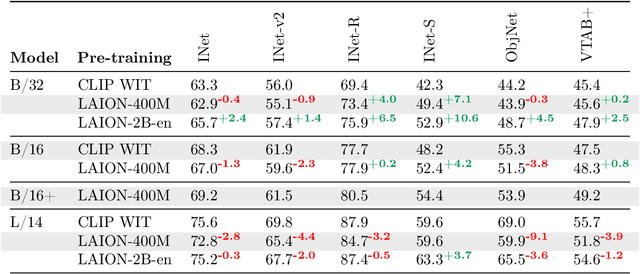Christoph Schuhmann
Project Alexandria: Towards Freeing Scientific Knowledge from Copyright Burdens via LLMs
Feb 26, 2025Abstract:Paywalls, licenses and copyright rules often restrict the broad dissemination and reuse of scientific knowledge. We take the position that it is both legally and technically feasible to extract the scientific knowledge in scholarly texts. Current methods, like text embeddings, fail to reliably preserve factual content, and simple paraphrasing may not be legally sound. We urge the community to adopt a new idea: convert scholarly documents into Knowledge Units using LLMs. These units use structured data capturing entities, attributes and relationships without stylistic content. We provide evidence that Knowledge Units: (1) form a legally defensible framework for sharing knowledge from copyrighted research texts, based on legal analyses of German copyright law and U.S. Fair Use doctrine, and (2) preserve most (~95%) factual knowledge from original text, measured by MCQ performance on facts from the original copyrighted text across four research domains. Freeing scientific knowledge from copyright promises transformative benefits for scientific research and education by allowing language models to reuse important facts from copyrighted text. To support this, we share open-source tools for converting research documents into Knowledge Units. Overall, our work posits the feasibility of democratizing access to scientific knowledge while respecting copyright.
OpenAssistant Conversations -- Democratizing Large Language Model Alignment
Apr 14, 2023



Abstract:Aligning large language models (LLMs) with human preferences has proven to drastically improve usability and has driven rapid adoption as demonstrated by ChatGPT. Alignment techniques such as supervised fine-tuning (SFT) and reinforcement learning from human feedback (RLHF) greatly reduce the required skill and domain knowledge to effectively harness the capabilities of LLMs, increasing their accessibility and utility across various domains. However, state-of-the-art alignment techniques like RLHF rely on high-quality human feedback data, which is expensive to create and often remains proprietary. In an effort to democratize research on large-scale alignment, we release OpenAssistant Conversations, a human-generated, human-annotated assistant-style conversation corpus consisting of 161,443 messages distributed across 66,497 conversation trees, in 35 different languages, annotated with 461,292 quality ratings. The corpus is a product of a worldwide crowd-sourcing effort involving over 13,500 volunteers. To demonstrate the OpenAssistant Conversations dataset's effectiveness, we present OpenAssistant, the first fully open-source large-scale instruction-tuned model to be trained on human data. A preference study revealed that OpenAssistant replies are comparably preferred to GPT-3.5-turbo (ChatGPT) with a relative winrate of 48.3% vs. 51.7% respectively. We release our code and data under fully permissive licenses.
Reproducible scaling laws for contrastive language-image learning
Dec 14, 2022Abstract:Scaling up neural networks has led to remarkable performance across a wide range of tasks. Moreover, performance often follows reliable scaling laws as a function of training set size, model size, and compute, which offers valuable guidance as large-scale experiments are becoming increasingly expensive. However, previous work on scaling laws has primarily used private data \& models or focused on uni-modal language or vision learning. To address these limitations, we investigate scaling laws for contrastive language-image pre-training (CLIP) with the public LAION dataset and the open-source OpenCLIP repository. Our large-scale experiments involve models trained on up to two billion image-text pairs and identify power law scaling for multiple downstream tasks including zero-shot classification, retrieval, linear probing, and end-to-end fine-tuning. We find that the training distribution plays a key role in scaling laws as the OpenAI and OpenCLIP models exhibit different scaling behavior despite identical model architectures and similar training recipes. We open-source our evaluation workflow and all models, including the largest public CLIP models, to ensure reproducibility and make scaling laws research more accessible. Source code and instructions to reproduce this study will be available at https://github.com/LAION-AI/scaling-laws-openclip
LAION-5B: An open large-scale dataset for training next generation image-text models
Oct 16, 2022



Abstract:Groundbreaking language-vision architectures like CLIP and DALL-E proved the utility of training on large amounts of noisy image-text data, without relying on expensive accurate labels used in standard vision unimodal supervised learning. The resulting models showed capabilities of strong text-guided image generation and transfer to downstream tasks, while performing remarkably at zero-shot classification with noteworthy out-of-distribution robustness. Since then, large-scale language-vision models like ALIGN, BASIC, GLIDE, Flamingo and Imagen made further improvements. Studying the training and capabilities of such models requires datasets containing billions of image-text pairs. Until now, no datasets of this size have been made openly available for the broader research community. To address this problem and democratize research on large-scale multi-modal models, we present LAION-5B - a dataset consisting of 5.85 billion CLIP-filtered image-text pairs, of which 2.32B contain English language. We show successful replication and fine-tuning of foundational models like CLIP, GLIDE and Stable Diffusion using the dataset, and discuss further experiments enabled with an openly available dataset of this scale. Additionally we provide several nearest neighbor indices, an improved web-interface for dataset exploration and subset generation, and detection scores for watermark, NSFW, and toxic content detection. Announcement page https://laion.ai/laion-5b-a-new-era-of-open-large-scale-multi-modal-datasets/
LAION-400M: Open Dataset of CLIP-Filtered 400 Million Image-Text Pairs
Nov 03, 2021



Abstract:Multi-modal language-vision models trained on hundreds of millions of image-text pairs (e.g. CLIP, DALL-E) gained a recent surge, showing remarkable capability to perform zero- or few-shot learning and transfer even in absence of per-sample labels on target image data. Despite this trend, to date there has been no publicly available datasets of sufficient scale for training such models from scratch. To address this issue, in a community effort we build and release for public LAION-400M, a dataset with CLIP-filtered 400 million image-text pairs, their CLIP embeddings and kNN indices that allow efficient similarity search.
 Add to Chrome
Add to Chrome Add to Firefox
Add to Firefox Add to Edge
Add to Edge